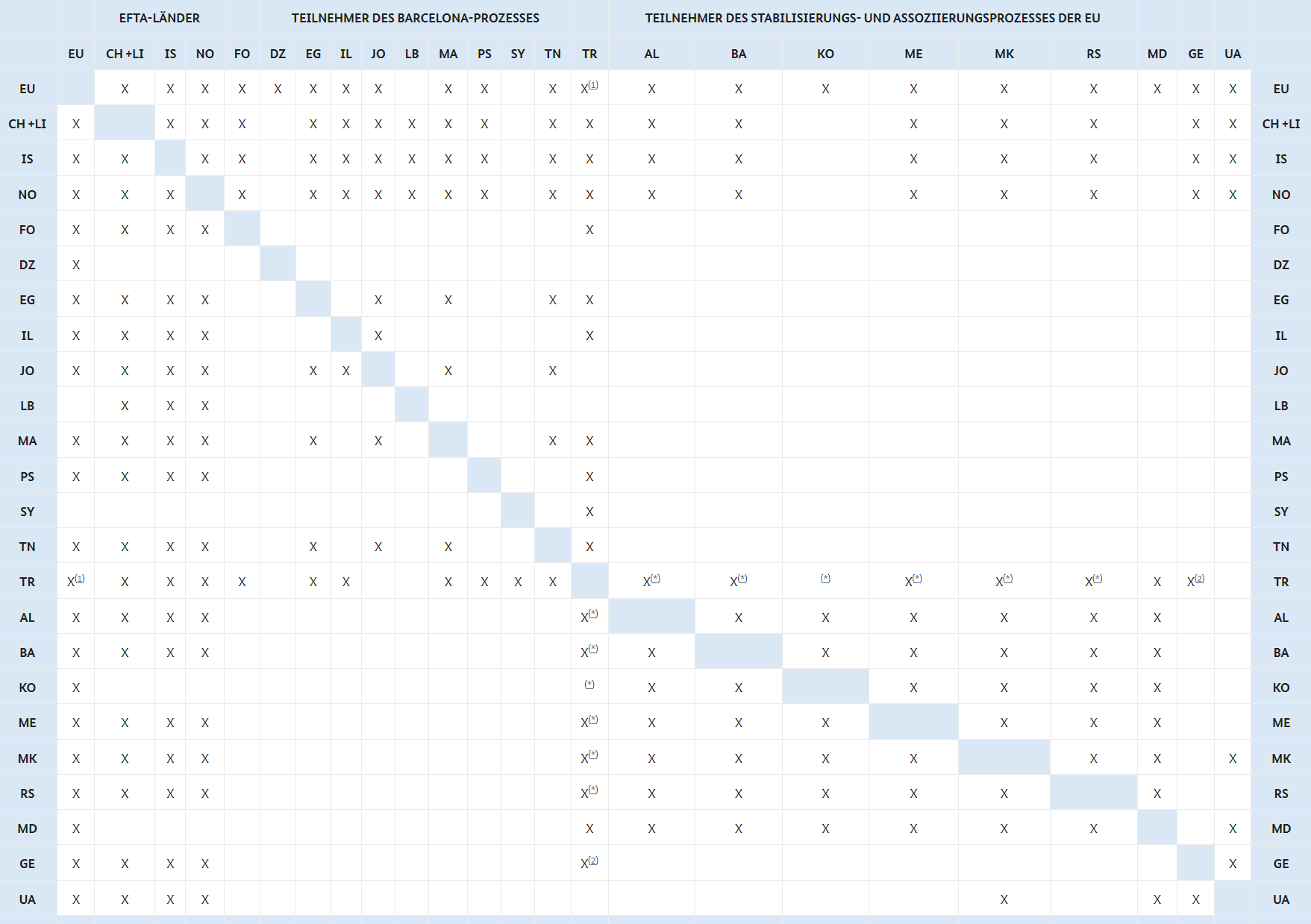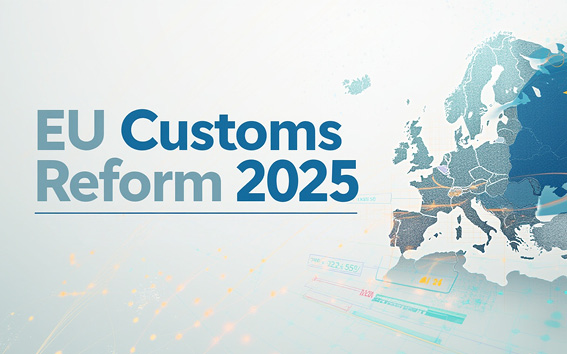At the turn of the year 2024/2025, far-reaching changes came into effect in the area of origin of goods and preferences. These require adaptations of or GENESYS software as well as the cooperation of those responsible in the companies that use this software. The changes affect companies in the EU and Switzerland. Companies in the UK are not affected.
The changes affect companies in the EU and Switzerland that use BEX software. Companies in the UK are not affected. The rules will not be changed for countries outside the PEM zone, such as South Korea, Mexico, Japan, and Canada.
This article is the central location for all currently known and forthcoming specialist information, instructions and calls to action.
What are PEM and the Regional Convention?
The Pan-European Mediterranean zone of origin (short: Pan-Euro-Med or PEM zone) is a group of countries that have concluded numerous bilateral free trade agreements with each other since 2005, using the same rules of origin and thus creating the basis for the Pan-Euro-Mediterranean cumulation.
It turned out to be difficult to amend a large number of agreements at the same time. The aim was not to jeopardize the system of identical rules of origin. For this reason, the rules of origin were combined into a separate set of rules in 2013 – the so-called Regional Convention. From then on, the free trade agreements referred only to the rules of the Regional Convention for the origin protocol, which sets out the rules for the preferential origin of goods. In order to change the rules of origin, the change only needs to be made in the Regional Convention and no longer needs to be implemented in all bilateral preferential agreements.
The contracting parties have agreed on such a change to the rules of origin from January 1, 2025. The Pan-Euro-Med matrix describes which countries from the PEM zone have concluded agreements with each other and are therefore allowed to cumulate. The application of the Regional Convention is indicated by a date with the suffix “(C)”. The change in the rules from January 1, 2025 is marked with an “(R)”.
Not all free trade agreements have yet been converted to the Regional Convention. It is to be expected that free trade agreements will continue to switch to the new rules beyond January 1, 2025 and that information will be published on how to proceed until then.

Section of the Pan-Euro-Med matrix of German customs using Switzerland as an example. (Status: 01/07/2025)
What will change?
Viewed in isolation, the new rules are easier to comply with. The main long-term simplifications coming into force are the following:
- Increase in general tolerance from 10% to 15%
- Changes to the content and structure of the list rules, in particular through:
- Increase in the proportion of permitted non-originating materials depending on the ex-works price; ergo higher percentage
- Reduction of combination rules
- Introduction of weight rules
- Simplifications for the textile and chemical sectors through special procedures, additional textual rules that may apply
- Many header rules are summarized in the chapter rules; i.e. omission of many ex-rules for HS heading or HS sub-heading
- Movement certificate EUR-MED and declaration of origin on the invoice EUR-MED are no longer required
As a result of these changes, existing rule assignments must be dissolved and rules reassigned. Accordingly, the calculations and assessments must be carried out again.
When will the rule change come into force?
This rule change came into force on January 1, 2025. This means that agreements marked with an “(R)” in the matrix only apply the new rules of origin without an alternative from this date.
In addition, on December 12, 2024, the Joint Committee of the PEM Convention decided to extend the existing rules of the Regional Convention in addition to other transitional provisions. This means that the previous rules can be used for a further year, provided that the parties to the agreement ratify these transitional provisions.
Update (01/07/2025)
Maintenance of supplier’s declarations for the Regional Convention (PEM)
The reform of the Regional Convention is currently creating more and more ambiguity in preferential law. Particular care is required if you maintain supplier’s declarations for agreements in the pan-Euro-Med cumulation zone.
Short overview of the reform
With Resolution 1/2023 of December 7, 2023, the rules and regulations of the Regional Convention were to be completely replaced by a new set of rules from January 1, 2025. However, on December 12, 2024, the previous set of rules was extended for an additional year as an alternative by Resolution 1/2024 of the Joint Committee of the Regional Convention. However, this resolution requires national ratification, which is why it had not yet been implemented by all states by January 1, 2025.
In GENESYS, the agreements with Albania and Montenegro for the EU and CH jurisdictions were therefore converted to the revised rules of the Regional Convention as of January 1, 2025. This step cannot be reversed, even if ratification takes place at a later date and the old rules are applicable again.
Update (12/17/2024)
Effects on the GENESYS software and your processes
EU location:
It is not yet clear which EU agreement partners that already have a reference to the regional agreement can still ratify the agreement by December 31, 2024. It is becoming apparent that a changeover will have to be made for individual EU agreements.
For the EU jurisdiction, the widget for the changeover will be delivered at the turn of the year for at least some agreements.
Switzerland location:
In a notification dated December 16, 2024, the Federal Office for Customs and Border Security (FOCBS) informed that the following agreements have been ratified by Switzerland and that the previous rules will continue to apply temporarily:
- CH – EU
- EFTA Convention:
- North Macedonia
- Turkey
For the following agreements the situation is not yet clear, but it is likely that the existing rules will continue to apply temporarily:
- EFTA – Bosnia and Herzegovina
- EFTA – Georgia
- EFTA – Albania
- EFTA – Montenegro
These conditions will not be met for the EFTA-Serbia Agreement, so the revised rules of the Regional Agreement will have to be applied.
For the Swiss jurisdiction, the widget for the changeover will therefore be delivered at the turn of the year, at least for Serbia.
BEX continues to monitor the situation and possible short-term ratifications and announcements for both locations. We will provide a service pack in line with the situation on December 30, 2024. This will include the necessary adjustments. You will be guided through all the necessary steps via a widget.
For the software operated in the cloud, the service pack will be installed automatically. If you are running GENESYS as an on-premises installation, you will need to install the service pack yourself.
Technical information and instructions
Possible variants for the maintenance of supplier’s declarations
- Supplier’s declarations without remarks
These are interpreted as calculated according to the old rules of the Regional Convention and may be adopted as confirmed agreements for all listed agreements that have not been converted in GENESYS.
Agreements that have been converted in GENESYS can be recognized by the addition in brackets (RR) in the “Agreements” pop-up when maintaining the “Confirmed agreements” field. Special regulations apply to these, as the permeability of the old rules to the new rules only applies in simplified form to goods from Chapter 25-97 of the Harmonized System and, according to the previous application of the law, only to supplier’s declarations on which “no cumulation applied” was confirmed. This will be easier in the future. The EU Commission is currently revising the legal provisions for the maintenance of supplier’s declarations in the Union Customs Code (UCC).
Practical implications: Only maintain supplier’s declarations for countries with converted agreements if they confirm “no cumulation applied” and the items are goods of chapters 25-97 of the Harmonized System.
- Supplier’s declarations with remark for confirmed transitional rules
Agreements for which the transitional rules have been confirmed may continue to be used for cumulation with the revised rules.
Practical implications: Maintain these supplier’s declarations only for agreements outside the PEM zone (e.g. Canada, Japan, or Chile) and the agreements that have already been converted, which are displayed with added (RR) in the “Agreements” pop-up under “Confirmed agreements”.
- Supplier’s declarations with “REVISED RULES” remark
Agreements for which the “REVISED RULES” remark has been confirmed may only be used for cumulation with the revised rules. Therefore, check whether the remark applies to all potential countries in the PEM zone or only to individual countries. This is often evident from footnotes or similar indicators.
Practical implications: Maintain these supplier’s declarations as usual for the agreements outside the PEM zone (e.g. Canada, Japan, or Chile) and for the agreements already converted in GENESYS. These can be recognized by the added (RR) in the “Agreements” pop-up under “Confirmed agreements”.Agreements from the PEM area that have been issued on this declaration according to the old rules – you can recognize this by the different remarks – can also be maintained as confirmed agreements.
Which preparations do GENESYS users need to take?
- Allocate specialist resources for the turn of the year 2024/2025, e.g. for rule assignment and, if necessary, the creation of manual list rules.
- Block the necessary capacities and also take into account any customer-specific changes, e.g. customized forms, in your budget.



